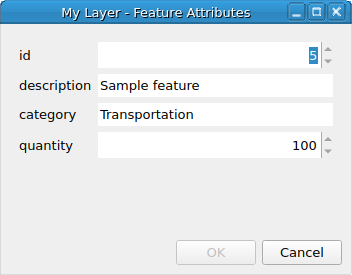Class: QgsAttributeDialog¶
An attribute table dialog for a vector layer.

QgsAttributeDialog in QgsAttributeEditorContext.Mode.SingleEditMode¶
Class Hierarchy¶
Base classes¶
An interface for objects which can create a |
Methods
Returns the attribute form. |
|
Is this dialog editable? |
|
Returns the current feature of the attribute form. |
|
Sets the edit command message (Undo) that will be used when the dialog is accepted |
|
Sets extraScope as an additional expression context scope to be used for calculations in this form. |
|
setHighlight |
|
Toggles the form mode. |
|
Show the dialog non-blocking. |
Virtual Methods
In PyQGIS, only methods marked as virtual can be safely overridden in a Python subclass of QgsAttributeDialog. See the FAQ for more details.
Intercept window activate/deactivate events to show/hide the highlighted feature. |
- class qgis.gui.QgsAttributeDialog[source]¶
Bases:
QDialog,QgsMapLayerActionContextGenerator- __init__(vl: QgsVectorLayer | None, thepFeature: QgsFeature | None, featureOwner: bool, parent: QWidget | None = None, showDialogButtons: bool = True, context: QgsAttributeEditorContext = QgsAttributeEditorContext())
Create an attribute dialog for a given layer and feature
- Parameters:
vl (Optional[QgsVectorLayer]) – The layer for which the dialog will be generated
thepFeature (Optional[QgsFeature]) – A feature for which the dialog will be generated
featureOwner (bool) – Set to
True, if the dialog should take ownership of the featureparent (Optional[QWidget] = None) – A parent widget for the dialog
showDialogButtons (bool = True) –
True: Show the dialog buttons accept/cancelcontext (
QgsAttributeEditorContext= QgsAttributeEditorContext()) – The context in which this dialog is created
- attributeForm(self) QgsAttributeForm | None[source]¶
Returns the attribute form.
- Return type:
Optional[QgsAttributeForm]
- editable(self) bool[source]¶
Is this dialog editable?
- Return type:
bool
- Returns:
returns
True, if this dialog was created in an editable manner.
- virtual event(self, e: QEvent | None) bool[source]¶
Intercept window activate/deactivate events to show/hide the highlighted feature.
- Parameters:
e (Optional[QEvent]) – The event
- Return type:
bool
- Returns:
The same as the parent QDialog
- feature(self) QgsFeature | None[source]¶
Returns the current feature of the attribute form.
- Return type:
Optional[QgsFeature]
- setEditCommandMessage(self, message: str | None)[source]¶
Sets the edit command message (Undo) that will be used when the dialog is accepted
- Parameters:
message (Optional[str]) – The message
- setExtraContextScope(self, extraScope: QgsExpressionContextScope | None)[source]¶
Sets
extraScopeas an additional expression context scope to be used for calculations in this form.Added in version 3.16.
- Parameters:
extraScope (Optional[QgsExpressionContextScope])
- setHighlight(self, h: QgsHighlight | None)[source]¶
- setHighlight(None) None
- Parameters:
h (Optional[QgsHighlight]) – The highlight. Ownership is taken.
- setMode(self, mode: QgsAttributeEditorContext.Mode)[source]¶
Toggles the form mode.
- Parameters:
mode (QgsAttributeEditorContext.Mode) – form mode. For example, if set to
QgsAttributeEditorContext.AddFeatureMode, the dialog will be editable even with an invalid feature and will add a new feature when the form is accepted.